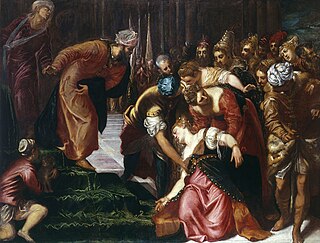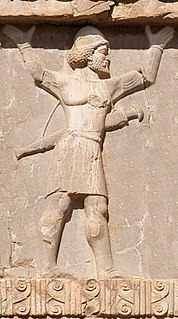Related Research Articles

Xerxes I, commonly known as Xerxes the Great, was the fourth King of Kings of the Achaemenid Empire, ruling from 486 to 465 BC. He was the son and successor of Darius the Great and his mother was Atossa, a daughter of Cyrus the Great, the first Achaemenid king. Like his father, he ruled the empire at its territorial apex. He ruled from 486 BC until his assassination in 465 BC at the hands of Artabanus, the commander of the royal bodyguard.

Darius I, commonly known as Darius the Great, was the third Persian King of Kings of the Achaemenid Empire, reigning from 522 BCE until his death in 486 BCE. He ruled the empire at its peak, when it included much of West Asia, parts of the Caucasus, parts of the Balkans, most of the Black Sea coastal regions, Central Asia, as far as the Indus Valley in the far east and portions of north and northeast Africa including Egypt (Mudrâya), eastern Libya, and coastal Sudan.

The Battle of Salamis was a naval battle fought between an alliance of Greek city-states under Themistocles, and the Persian Empire under King Xerxes in 480 BC. It resulted in a decisive victory for the outnumbered Greeks. The battle was fought in the straits between the mainland and Salamis, an island in the Saronic Gulf near Athens, and marked the high point of the second Persian invasion of Greece.

Ahasuerus is a name applied in the Hebrew Bible to three rulers and to a Babylonian official in the Book of Tobit.

The Battle of Thermopylae was fought between an alliance of Greek city-states, led by King Leonidas I of Sparta, and the Achaemenid Empire of Xerxes I. It was fought over the course of three days, during the second Persian invasion of Greece. The battle took place simultaneously with the naval battle at Artemisium. It was held at the narrow coastal pass of Thermopylae in August or September 480 BC. The Persian invasion was a delayed response to the defeat of the first Persian invasion of Greece, which had been ended by the Athenian victory at the Battle of Marathon in 490 BC. By 480 BC, Xerxes had amassed a massive army and navy and set out to conquer all of Greece. The Athenian politician and general Themistocles had proposed that the allied Greeks block the advance of the Persian army at the pass of Thermopylae, while simultaneously blocking the Persian navy at the Straits of Artemisium.
Artabazos was a Persian general in the army of Xerxes I, and later satrap of Hellespontine Phrygia under the Achaemenid dynasty, founder of the Pharnacid dynasty of satraps. He was the son of Pharnaces, who was the younger brother of Hystaspes, father of Darius I. Artabazos was therefore a first cousin of the great Achaemenid ruler Darius I.

The Greco-Persian Wars were a series of conflicts between the Achaemenid Empire and Greek city-states that started in 499 BC and lasted until 449 BC. The collision between the fractious political world of the Greeks and the enormous empire of the Persians began when Cyrus the Great conquered the Greek-inhabited region of Ionia in 547 BC. Struggling to control the independent-minded cities of Ionia, the Persians appointed tyrants to rule each of them. This would prove to be the source of much trouble for the Greeks and Persians alike.

The Battle of Artemisium, or Battle of Artemision, was a series of naval engagements over three days during the second Persian invasion of Greece. The battle took place simultaneously with the land battle at Thermopylae, in August or September 480 BC, off the coast of Euboea and was fought between an alliance of Greek city-states, including Sparta, Athens, Corinth and others, and the Persian Empire of Xerxes I.
Mardonius was a leading Persian military commander during the Persian Wars with Greece in the early 5th century BC who died at the Battle of Plataea.
Amestris was a Persian queen, the wife of Xerxes I of Persia, mother of Achaemenid King of Kings Artaxerxes I of Persia.
Parmys was a Persian princess, the only daughter of Bardiya (Smerdis), son of Cyrus the Great. She was the grand daughter of Cyrus the Great, and Cassandane.

The Siege of Eretria took place in 490 BC, during the first Persian invasion of Greece. The city of Eretria, on Euboea, was besieged by a strong Persian force under the command of Datis and Artaphernes.

Masistes was a Persian prince of the Achaemenid Dynasty, son of king Darius I and of his wife Atossa, and full brother of king Xerxes I. He was satrap (governor) of Bactria during his brother's reign, where he attempted to start a revolt in 478 BC.
Artystone was a Persian princess, daughter of king Cyrus the Great, and sister or half-sister of Cambyses II, Atossa and Smerdis (Bardiyā). Along with Atossa and her niece Parmys, Artystone married king Darius I. It is argued that by marrying the female offspring of Cyrus, the founder of the empire, the new king aimed to prevent his rule from being contested, since Darius himself was not of royal blood.

The first Persian invasion of Greece, during the Persian Wars, began in 492 BC, and ended with the decisive Athenian victory at the Battle of Marathon in 490 BC. The invasion, consisting of two distinct campaigns, was ordered by the Persian king Darius the Great primarily in order to punish the city-states of Athens and Eretria. These cities had supported the cities of Ionia during their revolt against Persian rule, thus incurring the wrath of Darius. Darius also saw the opportunity to extend his empire into Europe, and to secure its western frontier.

The second Persian invasion of Greece occurred during the Greco-Persian Wars, as King Xerxes I of Persia sought to conquer all of Greece. The invasion was a direct, if delayed, response to the defeat of the first Persian invasion of Greece at the Battle of Marathon, which ended Darius I's attempts to subjugate Greece. After Darius's death, his son Xerxes spent several years planning for the second invasion, mustering an enormous army and navy. The Athenians and Spartans led the Greek resistance. About a tenth of the Greek city-states joined the 'Allied' effort; most remained neutral or submitted to Xerxes.

Ariabignes was one of the sons of the Persian king Darius I and his mother was a daughter of Gobryas (Γοβρύας). He participated in the Second Persian invasion of Greece, as one of the four admirals of the fleet of his brother Xerxes I, and was killed in the Battle of Salamis in 480 BC. Ariabignes was the commander of the Carian and Ionian forces.

The Achaemenid Empire, also called the First Persian Empire, was an ancient Iranian empire based in Western Asia founded by Cyrus the Great. Ranging at its greatest extent from the Balkans and Eastern Europe proper in the west to the Indus Valley in the east, it was larger than any previous empire in history, spanning 5.5 million square kilometers. It is notable for its successful model of a centralised, bureaucratic administration, for its multicultural policy, for building infrastructure such as road systems and a postal system, the use of an official language across its territories, and the development of civil services and a large professional army. The empire's successes inspired similar systems in later empires.

Artabanus was a son of Hystaspes, and therefore brother of Darius I as well as uncle of Xerxes I.

Artyphius was a general of the Achaemenid Army during the Second Persian invasion of Greece. He was the son of Artabanus, grandson of Hystaspes, and therefore nephew of Darius the Great and first degree cousin of Xerxes I.
References
- ↑ Lendering, J: "Parmys", in http://www.livius.org
- ↑ Crabb, George (1825). Universal Historical Dictionary. London: Baldwin, Cradock, and Joy. p. 108. Retrieved 25 July 2015.
ARIOMARDUS (Hist) 'Apiépapdoc, a son of Darius, who attended Xerxes into Greece. Herod. l. 7, c. 78. ARIOMAZES (Hist).
- ↑ Herodotus, Histories vii, 78
- ↑ Herodotus, Histories vii, 67
- ↑ Aeschylus, The Persians 38, 313.
![]() This article incorporates text from a publication now in the public domain : Smith, William, ed. (1870). "Ariomardus". Dictionary of Greek and Roman Biography and Mythology .
This article incorporates text from a publication now in the public domain : Smith, William, ed. (1870). "Ariomardus". Dictionary of Greek and Roman Biography and Mythology .